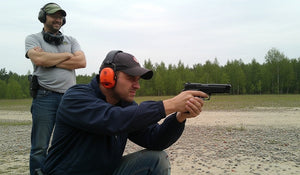You line up your sights, grip feels steady, finger’s on the trigger. The target’s centered. You squeeze—bam!—and… your pistol shoots low. Missed again.
Sounds familiar? Pistol shooting low is one of the most common problems shooters face at the range. And what’s worse, it can turn into a habit. Miss after miss, your group keeps dropping lower.
“Why am I shooting low with my pistol?”, that’s a frustrating question. The more it happens, the more you need to know the cause.
Is it your sights? Your grip? Or maybe a small mistake you don’t even realize you’re making, like flinching while shooting.
In this guide, we’ll break down why your pistol is hitting low and give you practical fixes. From trigger control and grip adjustments to smart gear upgrades, these are the pistol accuracy tips you need to get back on target.
Why Your Shots Are Hitting Low
The problem’s easy to describe: even when you feel like you’re aiming dead-center, your pistol keeps shooting low.
Fixing low pistol shots? That’s a little trickier. It could be poor trigger control, a grip issue, misaligned sights, or most likely, anticipation.
Let’s break down the common shooting mistakes that cause low hits, so you can start diagnosing your own shot pattern.
Hand grip tension
Your grip sets the foundation. A lot of shooters think they need to crush the pistol with their firing hand, but that usually causes problems.
Instead, focus on a balanced grip: firm, but not a death squeeze.
Also, take into account this: your support hand is actually where most of your stability comes from. One common mistake is squeezing all your fingers when pulling the trigger.
In reality, the only thing that should move is your trigger finger. The rest should stay locked and steady, keeping the gun stable as the shot breaks.
Misaligned sights
Sights can trick you. Especially for new shooters, it’s easy to line up left-to-right, but forget about the vertical alignment. If your front sight dips just a little low, you’ll see the target, but your shot will land low.
Some shooters think red dots are an automatic solution. They help, sure, but it’s not that easy. You still need proper calibration, and you need to account for mechanical offset. At close distances (10–15 yards), it’s barely noticeable, but stretch out to longer ranges and that offset will make a real difference.
Trigger finger and flinching
How you press the trigger can send shots low and off-center. Too much finger on the trigger? You’ll drag the pistol down and inward. Too little? You risk pushing it off the other way.
We already covered a lot of this on our trigger finger discipline guide here. Bad habits can start at your fingertips, literally.
Flinching while shooting; the silent killer of accuracy. Many shooters don’t even realize they’re doing it. That slight jerk as you expect recoil drives the muzzle down, making your shots hit low. Building better trigger control through self-awareness and practice is key.
Most probably, it’s anticipation
This is the big one. The number one cause of low hits is anticipation. You expect recoil, so your brain tells your hands to fight it, right before the break. The result? You subconsciously push the muzzle down, sending the shot low.
It’s one of those habits that sneaks in fast and sticks around. The good news is, with the right drills and focus, you can un-train it just as effectively. And we’ll cover exactly how to do that in the next section.
How to Diagnose Your Issue
Now that you know the common shooting mistakes that cause low hits. How do you figure out which one’s yours? Before you fix anything, you need to diagnose the problem.
Here are three easy methods to spot what’s really happening.
Record yourself shooting
Sometimes you can’t feel what you’re doing wrong, but you can see it. Ask one of your buddies and have them record you while shooting.
And here’s a few tips on what you want to get on camera: Get steady footage from different angles, especially close-ups of your grip and trigger pull.
Then slow it down and watch it back. You’ll spot little movements—like dipping the muzzle or jerking the trigger—that explain why your shots are landing low.
Dry fire test with a coin on the slide
This classic drill doubles as a diagnostic tool.
Just clear your pistol and make sure it’s unloaded. Place a penny or small coin flat on your front sight. Aim in and press the trigger slowly. If the coin stays balanced, your trigger control is solid. If it falls? That’s your problem.
This simple exercise will show you if you’re slapping the trigger or flinching while shooting. It’s one of the easiest pistol accuracy tips you can even practice at home.
Use a correction Target
Targets don’t lie. A shot correction target is a great way to see exactly what’s happening.
Grab a correction target (here’s a nice one from Pew Pew Tactical) and put it to use.
Each zone on the target corresponds to a shooting error: squeezing all your fingers, breaking your wrist down, pressing the trigger too hard, or even pushing with your thumb. If your group consistently lands in the “low” sections, you’ll know what to work on.
Once you’ve diagnosed the issue, you’re halfway there. Your pistol’s shooting low, and now you know why. Next step? Let’s fix it with drills that train you out of those habits.
Fixing the Problem: Drills & Techniques

Alright, enough about causes, let’s talk solutions. To fix the problem of your pistol shooting low, first we’re going to focus on four simple but technical drills. These are the range-tested methods that build better trigger control and eliminate those downward misses.
Dry Fire Drills
Dry fire is where bad habits get exposed. Unload your pistol, point it up slightly, and watch your grip and trigger finger as you press. You’ll see if your finger is pulling straight back or if it’s dragging the pistol sideways and low.
Too much finger inside the trigger guard usually sends rounds low and left (if you’re right-handed). Too little finger can push them the opposite way. The sweet spot is the center of your finger pad—right where you get a clean, straight press.
Dry firing is simple, safe, and productive. It's one of the best pistol accuracy tips you can even practice at home.
Slow controlled shooting
Most of us love speed shooting. But if your shots keep dropping low, one possible fix is to slow it down. At the range, pace yourself. Take your time on each rep: steady grip, clear sight picture, smooth trigger press.
Watch for subtle movements. A lot of shooters discover that little dip right at the trigger wall only when they slow down enough to notice it.
Take long pauses between shots if you need to. Don’t rush the follow-up. Once you’re consistently on target slow, you can start building speed back in without bringing the low hits with you.
Trigger Reset Drill
This live-fire drill teaches discipline and rhythm. Fire one shot and let the gun recoil. As the sights settle back on target, slowly release the trigger until you feel the reset click.
The instant the trigger resets and your sights are back on target, press again. Start slow, focus on smooth resets, then gradually speed up.
With the trigger reset drill you’ll build confidence in your follow-up shots, and prevent you from jerking the trigger low under pressure.
Mix Dummy Rounds With Live Ammo
Dummy rounds are cheap. Every shooter should have those for each caliber they shoot. When practicing, mix them randomly with live rounds in your mags. That way, you’ll never know what’s coming.
When you hit a dummy round, the gun won’t fire. If you flinch, dip the muzzle, or slap the trigger, you’ll see it instantly. That surprise factor trains you out of bad habits like anticipation.
Over time, this drill conditions you to keep the sights steady and press smoothly. From there, it’s cleaner hits and more confidence when it counts.
How Your Gear Affects Accuracy
Now comes the gear talk. While most low shots come down to technique, the right upgrades can make a huge difference.
Sights are first. Still running stock irons? At least upgrade to a fiber optic front. It makes a night-and-day change in clarity.
Moving to a red dot is another option, but you still need solid fundamentals. That said, a red dot does make it easier to see if you’re dipping the muzzle on the trigger press, especially during dry fire.
Next up is the trigger. A crisp trigger with a clean break helps reduce anticipation and jerking. If you’re running a Canik, you’re already ahead of the game—the TP9 and Rival series have some of the best stock triggers out there. But it still comes down to your finger. Trigger control drills will tell you if your current setup fits you right.
And finally, recoil management. Here’s where a lot of shooters overcompensate. This is exactly where a compensator can be of great help.
Upgrade Tip: Get Back on Target with 45Blast
Compensators have exploded in popularity because they’re simple to install and incredibly effective. By redirecting gases, a comp tames recoil and keeps your muzzle flat. Instead of you forcing the gun down, the comp helps you land shots where you want them.
For Canik shooters, a 45Blast compensator can reduce recoil by up to 80%. That’s a massive difference, especially if you struggle with flinching or anticipation. Our comps are proven to help shooters fire faster, stay accurate, and eliminate those dreaded low hits.
If your pistol is shooting low, upgrading to a 45Blast compensator is one of the smartest moves you can make. Check out our lineup and see the difference for yourself.
Solved! What’s How You Fix Low Pistol Shots
Shooting is all about precision, focus, and accuracy. If your pistol is shooting low, it’s a habit you need to break, not just for better performance. It’s also about confidence and safety.
Now you know the causes: it could be your grip, your sights, or your trigger pull. You also know the fixes: drills to build better trigger control, ways to diagnose your habits, and even gear upgrades to speed up the process.
With these pistol accuracy tips, you’ve got everything you need to put rounds where they belong: the A-zone.
So what’s next? Head to the range and put it all into practice. Run the drills. Check your sights. Dial in your grip. And if you want an edge, upgrade with a 45Blast compensator to keep your muzzle flat and your groups tight.
It’s time to say goodbye to low hits and start stacking shots dead-center where they should be.


